Global Amplitude-Type Spatial Light Modulator In-Depth Monitoring and Development Analysis Report 2024
The global Amplitude-Type Spatial Light Modulator market size in 2023 is xx million US dollars, and it is expected to be xx million US dollars by 2030, with a compound annual growth rate of xx% expected in 2024-2030.
MARKET COMPETITIVE LANDSCAPE:
The main players in the Amplitude-Type Spatial Light Modulator market include Hamamatsu Photonics K.K., Meadowlark Optics, Inc., Holoeye Photonics AG, SLM Solutions Group AG, and Jenoptik AG. The share of the top 3 players in the Amplitude-Type Spatial Light Modulator market is xx%.
REGION SHARE:
The report covers the market size information of North America, Europe, Asia Pacific, Latin America, Middle East and Africa, and North America accounted for xx%, Europe accounted for xx% of Amplitude-Type Spatial Light Modulator market, and Asia Pacific accounted for xx%.
SEGMENT OVERVIEW:
The report segments the market by Type and Application. Electro-Optic Modulator accounted for xx% of Amplitude-Type Spatial Light Modulator market in 2023. Aom share of xx%.
Optical Communication accounted for xx% of the Amplitude-Type Spatial Light Modulator market in 2023. Optical Imaging accounts for xx%.
This Amplitude-Type Spatial Light Modulator market report provides detailed information on latest developments, trade regulations, value chain optimization, market share, impact of domestic and local market players, analyzes emerging revenue sources, market regulation changes Opportunities in Aspects, Strategic Market Growth Analysis, Market Size, Category Market Growth, Application Areas and Dominance, Product Approvals, Product Launches, Geographic Expansion, Technological Innovations in the Market.
Amplitude-Type Spatial Light Modulator market country level analysis
The countries covered in the Amplitude-Type Spatial Light Modulator market report include the United States, Canada, Germany, United Kingdom, France, Russia, Japan, China, India, South Korea, Brazil, UAE, Saudi Arabia, etc.
The presence and availability of global brands and challenges due to intense or scarce competition from local and domestic brands, and trade routes are also considered while providing the predictive analysis of country data.
Amplitude-Type Spatial Light Modulator market competitive landscape provides details by competitors. The detailed information includes company profile, company financials, revenue generated, market potential, R&D investments, new market plans, global reach. The data points presented above relate only to companies relevant to the Amplitude-Type Spatial Light Modulator market.
Chapter Outline
Chapter 1: Introduces the product overview, market scope, product classification, and application division, and then includes research purposes, report timeline, and economic analysis of global regions.
Chapter 2: Analyzes the Amplitude-Type Spatial Light Modulator manufacturing cost, including raw material analysis, manufacturing cost structure, and industrial chain.
Chapters 3-8: Provide Global, North America, Europe, Asia-Pacific, Latin America and Middle East & Africa Amplitude-Type Spatial Light Modulator market type, application and country market segmentation data.
Chapters 9-10: Segmented the global Amplitude-Type Spatial Light Modulator market by type, and application. Analyze the revenue, sales and price of market segments from different perspectives.
Chapter 11: Introduces the market dynamics, the trends factors and drivers factors of the market, and the challenges and restraints faced by manufacturers in the industry, and includes industry mergers & acquisitions and industry new entrants and expansion plans.
Chapter 12: Analyzes the Amplitude-Type Spatial Light Modulator industry chain, including marketing channels, distributors and major downstream buyers.
Chapter 13: Analyzes the main companies in the Amplitude-Type Spatial Light Modulator industry, including their main businesses, products/services, sales, prices, revenue and gross margin.
Chapter 14: The main points and conclusions of the report.
Highlights-Regions
North America
United States
Canada
Asia Pacific
China
Japan
Korea
Southeast Asia
India
Australia
Europe
Germany
France
UK
Italy
Russia
Spain
Nordic
Latin America
Brazil
Argentina
Colombia
Mexico
Middle East & Africa
Egypt
South Africa
Israel
Turkey
GCC Countries
Player list
Hamamatsu Photonics K.K.
Meadowlark Optics, Inc.
Holoeye Photonics AG
SLM Solutions Group AG
Jenoptik AG
Forth Dimension Displays Ltd.
AOMS Technologies Inc.
CILAS
Boulder Nonlinear Systems, Inc.
Boston Micromachines Corporation
HoloOr Ltd.
Laser 2000 GmbH
Cognex Corporation
Micos Telcom
Meadowlark Optics, Inc.
HOLOEYE Systems, Inc.
Types list
Electro-Optic Modulator
Aom
Magneto-Optic Modulator
Application list
Optical Communication
Optical Imaging
Optical Measurement
Optical Sensor
Optical Interference
Others
MARKET COMPETITIVE LANDSCAPE:
The main players in the Amplitude-Type Spatial Light Modulator market include Hamamatsu Photonics K.K., Meadowlark Optics, Inc., Holoeye Photonics AG, SLM Solutions Group AG, and Jenoptik AG. The share of the top 3 players in the Amplitude-Type Spatial Light Modulator market is xx%.
REGION SHARE:
The report covers the market size information of North America, Europe, Asia Pacific, Latin America, Middle East and Africa, and North America accounted for xx%, Europe accounted for xx% of Amplitude-Type Spatial Light Modulator market, and Asia Pacific accounted for xx%.
SEGMENT OVERVIEW:
The report segments the market by Type and Application. Electro-Optic Modulator accounted for xx% of Amplitude-Type Spatial Light Modulator market in 2023. Aom share of xx%.
Optical Communication accounted for xx% of the Amplitude-Type Spatial Light Modulator market in 2023. Optical Imaging accounts for xx%.
This Amplitude-Type Spatial Light Modulator market report provides detailed information on latest developments, trade regulations, value chain optimization, market share, impact of domestic and local market players, analyzes emerging revenue sources, market regulation changes Opportunities in Aspects, Strategic Market Growth Analysis, Market Size, Category Market Growth, Application Areas and Dominance, Product Approvals, Product Launches, Geographic Expansion, Technological Innovations in the Market.
Amplitude-Type Spatial Light Modulator market country level analysis
The countries covered in the Amplitude-Type Spatial Light Modulator market report include the United States, Canada, Germany, United Kingdom, France, Russia, Japan, China, India, South Korea, Brazil, UAE, Saudi Arabia, etc.
The presence and availability of global brands and challenges due to intense or scarce competition from local and domestic brands, and trade routes are also considered while providing the predictive analysis of country data.
Competitive Landscape
and Amplitude-Type Spatial Light Modulator Market Share AnalysisAmplitude-Type Spatial Light Modulator market competitive landscape provides details by competitors. The detailed information includes company profile, company financials, revenue generated, market potential, R&D investments, new market plans, global reach. The data points presented above relate only to companies relevant to the Amplitude-Type Spatial Light Modulator market.
Chapter Outline
Chapter 1: Introduces the product overview, market scope, product classification, and application division, and then includes research purposes, report timeline, and economic analysis of global regions.
Chapter 2: Analyzes the Amplitude-Type Spatial Light Modulator manufacturing cost, including raw material analysis, manufacturing cost structure, and industrial chain.
Chapters 3-8: Provide Global, North America, Europe, Asia-Pacific, Latin America and Middle East & Africa Amplitude-Type Spatial Light Modulator market type, application and country market segmentation data.
Chapters 9-10: Segmented the global Amplitude-Type Spatial Light Modulator market by type, and application. Analyze the revenue, sales and price of market segments from different perspectives.
Chapter 11: Introduces the market dynamics, the trends factors and drivers factors of the market, and the challenges and restraints faced by manufacturers in the industry, and includes industry mergers & acquisitions and industry new entrants and expansion plans.
Chapter 12: Analyzes the Amplitude-Type Spatial Light Modulator industry chain, including marketing channels, distributors and major downstream buyers.
Chapter 13: Analyzes the main companies in the Amplitude-Type Spatial Light Modulator industry, including their main businesses, products/services, sales, prices, revenue and gross margin.
Chapter 14: The main points and conclusions of the report.
Highlights-Regions
North America
United States
Canada
Asia Pacific
China
Japan
Korea
Southeast Asia
India
Australia
Europe
Germany
France
UK
Italy
Russia
Spain
Nordic
Latin America
Brazil
Argentina
Colombia
Mexico
Middle East & Africa
Egypt
South Africa
Israel
Turkey
GCC Countries
Player list
Hamamatsu Photonics K.K.
Meadowlark Optics, Inc.
Holoeye Photonics AG
SLM Solutions Group AG
Jenoptik AG
Forth Dimension Displays Ltd.
AOMS Technologies Inc.
CILAS
Boulder Nonlinear Systems, Inc.
Boston Micromachines Corporation
HoloOr Ltd.
Laser 2000 GmbH
Cognex Corporation
Micos Telcom
Meadowlark Optics, Inc.
HOLOEYE Systems, Inc.
Types list
Electro-Optic Modulator
Aom
Magneto-Optic Modulator
Application list
Optical Communication
Optical Imaging
Optical Measurement
Optical Sensor
Optical Interference
Others
Frequently Asked Questions
This market study covers the global and regional market with an in-depth analysis of the overall growth prospects in the market. Furthermore, it sheds light on the comprehensive competitive landscape of the global market. The report further offers a dashboard overview of leading companies encompassing their successful marketing strategies, market contribution, recent developments in both historic and present contexts.
- By product type
- By End User/Applications
- By Technology
- By Region
The report provides a detailed evaluation of the market by highlighting information on different aspects which include drivers, restraints, opportunities, and threats. This information can help stakeholders to make appropriate decisions before investing.
Please Select a Format












